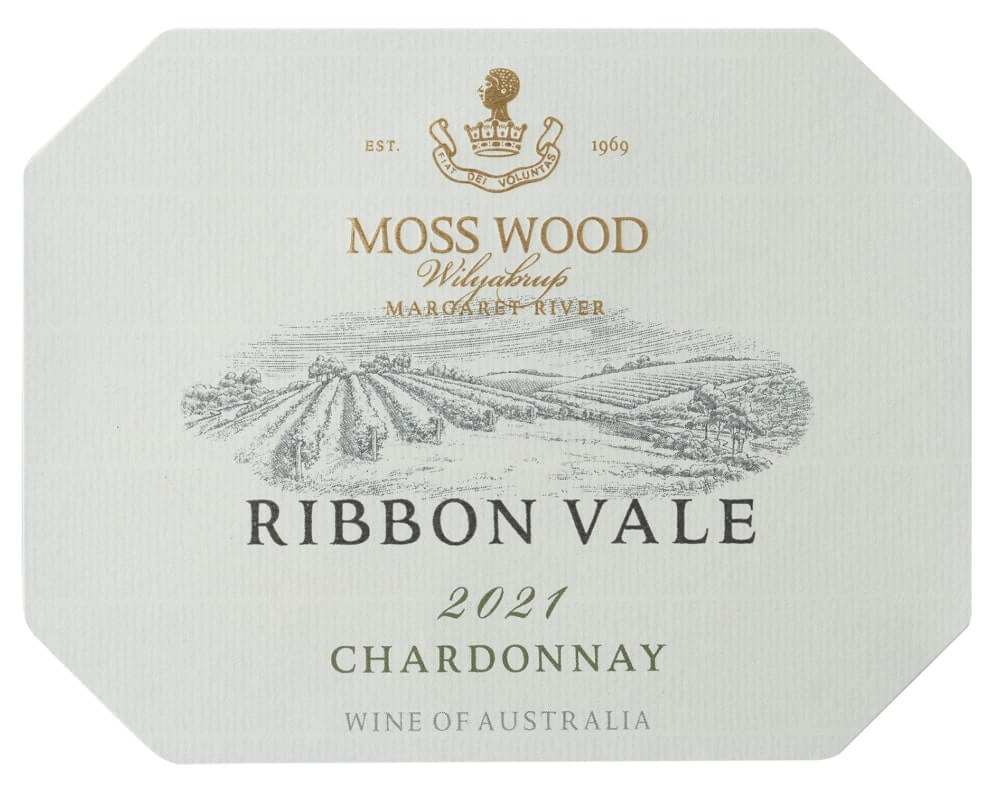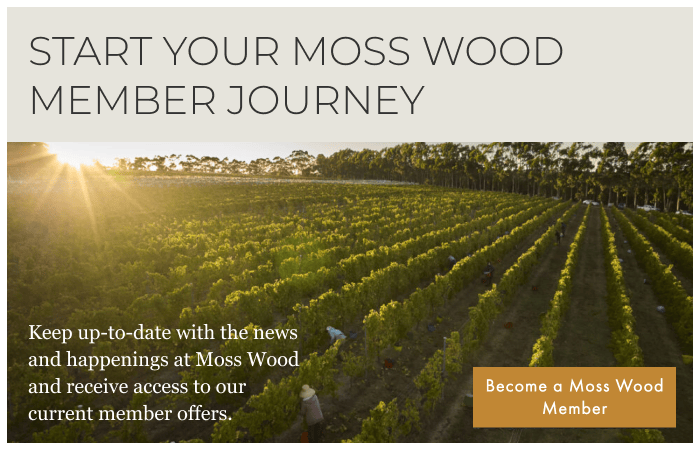Moss Wood Ribbon Vale 2021 Chardonnay

| Wine Facts | |
|---|---|
| Wine Facts Median Harvest Date | 25/03/2021 |
| Wine Facts Harvest Ripeness | 12.8 °Be |
| Wine Facts Yield | 5.38 t/ha |
| Wine Facts Day Elapsed between Flowering and Harvest | 128 days |
| Wine Facts Bottled | 14/01/2022 |
| Wine Facts Released | 04/03/2022 |
| Wine Facts Alcohol | 13.5% |
Wine Facts
-
Median Harvest Date
23/03/2021
-
Mean Harvest Ripeness
12.8 ⁰ Be
-
Yield
5.38 t/ha
-
Day Elapsed between Flowering and Harvest
128 days
-
Bottled
14/01/2022
-
Released
04/03/2022
-
Alcohol
13.5%
VINTAGE NOTES
2021 Ribbon Vale Vintage
The 2021 vintage was like travelling some way back in time, to 1989 in fact. It’s a long time since we’ve experienced the amount and timing of rain that ’89 brought us but in 2021 Mother Nature gave us another of her subtle reminders that she calls the shots.
Through the early part of the season, conditions were benign with good spring rain, mild temperatures and no big storms to belt the vineyards with strong winds and hail. Flowering proceeded in excellent conditions and we were hopeful of good crops.
As we moved through summer, it was notable that temperatures were on the low side, making beach-going conditions a little bit cool. Apart from that First World problem the vines made steady progress and we planned for a slightly later vintage. On 4th February, a Tropical Low crossed the WA coast at Shark Bay and the remnant rain made its way down the coast to Margaret River, where it delivered just over 80mm.
Fortunately, the 2021 growing season was cooler than 1989 and so when the rain came, both Sauvignon Blanc and Chardonnay were still relatively green. The berries were quite firm and didn’t split which in turn meant we had no disease problems and this allowed us to wait until temperatures warmed up and ripening got going again. That said, continuing mild conditions really tested our patience towards the end and we were relieved when Sauvignon Blanc was finally ready to harvest on 20th March, 3 weeks later than average. Chardonnay followed 5 days later.
Not surprisingly, given the regular rainfall, the season produced good crops. Sauvignon Blanc finally got moving after a succession of lighter years and gave us a solid 13 tonnes per hectare. Even for a variety with a propensity for high yields, we were pretty proud of that, especially given our vineyards are unirrigated. The Chardonnay, although a shy bearer, did well too, giving us just over 5 tonnes per hectare.
PRODUCTION NOTES
Chardonnay has a complicated history at Ribbon Vale and is worth recounting. When we first purchased the property in 2000, there was a small planting but it had never been used for an individual wine. Instead, it was blended into the two key wines of the time, Semillon and Sauvignon Blanc, for which the original owner, John James, had sound reasons. John was more interested in white Bordeaux than white Burgundy so Chardonnay wasn’t his favourite. This, combined with his frustration with the inconsistent yields for which Margaret River Chardonnay is famous, meant he never bothered making a Chardonnay wine.
After the Mugfords took over, we made varietal Chardonnay wines in both 2000 and 2001 but were never happy with the result and neither of them were released. We pulled the vines out and replaced them with the then darling of the market, Sauvignon Blanc.
At the time, as odd as this may seem now, demand for Sauvignon Blanc and Semillon, in both varietal and blended forms, was much stronger. Ribbon Vale had developed a good reputation for both and we felt it was important to continue with the wines for which the vineyard was best known. In addition, after just 2 growing seasons, our knowledge of Ribbon Vale’s terroir was fast evolving and we quickly learnt that it’s a very windy location and the negative impact on all the varieties but especially Chardonnay, was very significant.
The sea breezes that blow across the Margaret River region are an important contributor to our production of high quality wine. The resulting maritime climate avoids extremes of temperature and allows us to make the world-renowned products for which we are now known. However, high wind speeds cause serious problems for the vines, courtesy of the resulting physical damage to leaves and moisture stress. Chardonnay, which is a native of the relatively wind-free, continental climate of Burgundy, doesn’t take kindly to all this trauma, especially during spring and so it sets inconsistent crops. Those of us motivated by the style and quality of Margaret River Chardonnay just accept this reality and get on, but in the early days of the region it was a source of much debate.
To reduce the wind impact at Ribbon Vale, in 2001 we planted a large wind break along the southern boundary. It took just over a decade for the trees to reach a height where we could see they were starting to have an effect and now, twenty years later, the health of the leaves and the general performance of the vineyard is much-improved. We believe we can see the results in the recent vintages of the Elsa, Cabernet Sauvignon and Merlot, which all show a fruit depth and ripeness that we had previously struggled to achieve.
In the meantime, the wine market continues to evolve and consumers have developed a taste for Chardonnay, allowing it to supplant the Bordeaux varieties at the top of the quality pecking order, if not at the top of the yield table, where it still falls dismally short. We only need to look at our results for 2021 to see how stark the difference – Sauvignon Blanc, 13 tonnes per hectare, Chardonnay, 5 tonnes per hectare.
Most importantly, our improvements to the environment at Ribbon Vale mean it’s now a far more suitable vineyard for Chardonnay and as enthusiasts of this variety, we’ve re-established the plantings and are looking forward to what we can do with it. The 2021 we expect to be the first in a long line of these wines from the property.
Regular readers will know that at Moss Wood we’re quite well versed in the viticulture and winemaking of Chardonnay. As a refresher, it was originally planted here in 1976 and its first vintage was 1980. Please don’t read this as arrogant, but we’re confident we know our way around the variety. What is really exciting for us is we can use our expertise in the vineyard and winery and then step back and see just what style of wine Ribbon Vale produces. One of the fascinating things about Burgundian winemaking is the various domains produce individual wines, using similar techniques, from their different vineyards across the region and when the sibling wines are lined up side by side, the stylistic nuances are there for all to see. We’re looking forward to doing the same thing.
All this means the production techniques for Ribbon Vale Chardonnay are virtually identical to Moss Wood. There is a small difference in the choice of harvest date because the flavour profiles differ and ripeness at harvest may differ. Beyond that, it’s much the same. The fruit is hand-picked, delivered to the winery where the bunches are sorted and then put straight into the presses and the must is racked to stainless steel tanks, where it’s settled for 24 hours. The clear juice is then racked to a second tank, seeded with multiple yeast strains and allowed to ferment at 18°C until the halfway point is reached and then it’s racked to barrel to complete fermentation. All the barrels were 228 litre French oak and 25% were new. At the completion of primary fermentation, all barrels were racked and blended in stainless steel and the wine was then returned to wood for the malolactic fermentation. Once that was finished all barrels were blended again, adjusted for acidity and SO2 and the finished wine was returned to barrel for further aging.
In the first week of January 2022, all barrels were racked and blended in preparation for bottling. Fining trials were carried out to assess tannin balance but none improved the wine, so it remained unfined, apart from the use of bentonite for protein stability. It was then sterile filtered and bottled on 14th January 2022.
Tasting Notes
Colour and condition:
Medium straw hue, with green tints; bright condition.
Nose:
Aromas of white flesh nectarines, rock melon, honey, golden syrup, ginger bread and peach blossom, with caramel and roast nuts in the background and possibly freshly baked apple pie. Finishing with a light touch of toasty oak
Palate:
Medium to full bodied with a generous feel. There are nectarine, peach, lime and caramel or crème brulee flavours, as well as porridge and malt, sitting over a fresh acidity, which gives the wine real zip. There is some oak and tannin on the finish and some spicy oak and roast cashew notes.
Cellaring:
Like all good Margaret River Chardonnays, the wine has the necessary features to allow it to age for at least 15 years. The trick will be having the patience and strength of will to resist its early attractiveness because it’s an enjoyable young wine and can be consumed straight away.

